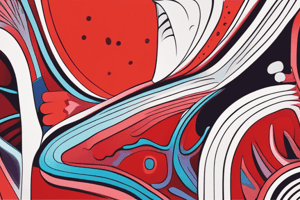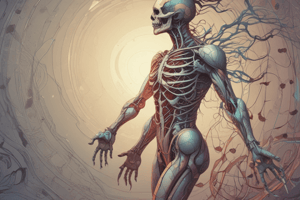Podcast
Questions and Answers
What does the red pulp of the spleen consist of?
What does the red pulp of the spleen consist of?
- Arterial sinus and cords of structures like blood cells, macrophages and mesenchymal cells
- Venous sinus and cords of structures like blood cells, macrophages and mesenchymal cells (correct)
- Venous sinus and cords of structures like white cells, macrophages and mesenchymal cells
- Arterial sinus and cords of structures like white cells, macrophages and mesenchymal cells
What is the structure of the spleen divided into?
What is the structure of the spleen divided into?
- White and blue pulp
- Red and white pulp (correct)
- Red and blue pulp
- Red and green pulp
Where is the spleen situated?
Where is the spleen situated?
- Lower left part of the abdomen, behind the stomach and just below the diaphragm
- Upper right part of the abdomen, behind the stomach and just below the diaphragm
- Upper left part of the abdomen, behind the stomach and just below the diaphragm (correct)
- Lower right part of the abdomen, behind the stomach and just below the diaphragm
What percentage of people have one or more accessory spleens?
What percentage of people have one or more accessory spleens?
What types of fibers and cells does the capsule, trabeculae and trabecular network of the spleen contain?
What types of fibers and cells does the capsule, trabeculae and trabecular network of the spleen contain?
What are the main functions of the spleen?
What are the main functions of the spleen?
What is the significance of the red pulp in the spleen?
What is the significance of the red pulp in the spleen?
What is the composition of the outer serous coat of the spleen?
What is the composition of the outer serous coat of the spleen?
How does the spleen receive its blood supply?
How does the spleen receive its blood supply?
What are the accessory spleens and where are they located?
What are the accessory spleens and where are they located?
What are the functions of the red pulp in the spleen?
What are the functions of the red pulp in the spleen?
How does the spleen contribute to the immune system?
How does the spleen contribute to the immune system?
What is the role of the venous sinus in the red pulp of the spleen?
What is the role of the venous sinus in the red pulp of the spleen?
What is the function of the trabecular network in the spleen?
What is the function of the trabecular network in the spleen?
How is the spleen connected to the circulatory system?
How is the spleen connected to the circulatory system?
What is the location of the spleen in the body?
What is the location of the spleen in the body?
What is the largest lymphoid organ in the body?
What is the largest lymphoid organ in the body?
What are accessory spleens?
What are accessory spleens?
What is the composition of the red pulp in the spleen?
What is the composition of the red pulp in the spleen?
What are the components of the capsule, trabeculae, and trabecular network in the spleen?
What are the components of the capsule, trabeculae, and trabecular network in the spleen?
Flashcards
White pulp & Red pulp
White pulp & Red pulp
Two main structures of the spleen.
Red pulp composition
Red pulp composition
The splenic cords and venous sinuses.
Spleen's location
Spleen's location
Located in the upper left abdominal cavity, below the diaphragm.
Splenic artery origin
Splenic artery origin
Signup and view all the flashcards
Accessory Spleens
Accessory Spleens
Signup and view all the flashcards
Spleen's functions
Spleen's functions
Signup and view all the flashcards
Red pulp function
Red pulp function
Signup and view all the flashcards
Venous sinus function
Venous sinus function
Signup and view all the flashcards
Trabecular network function
Trabecular network function
Signup and view all the flashcards
Spleen's role in immunity
Spleen's role in immunity
Signup and view all the flashcards
Study Notes
Spleen Structure and Composition
- The spleen is divided into two main structures: the white pulp and the red pulp.
- The red pulp consists of splenic cords and venous sinuses.
- The spleen is surrounded by a fibroelastic capsule, which contains collagenous fibers, elastic fibers, and smooth muscle cells.
- The trabeculae, which are extensions of the capsule, branch into the spleen and contain smooth muscle cells, collagenous fibers, and elastic fibers.
- The trabecular network is a three-dimensional structure that provides support to the spleen.
Spleen Location and Blood Supply
- The spleen is situated in the upper left region of the abdominal cavity, just below the diaphragm.
- The spleen receives its blood supply from the splenic artery, which arises from the celiac trunk.
Accessory Spleens
- Approximately 10-30% of people have one or more accessory spleens, which are small, functional spleens located outside the main spleen.
- Accessory spleens are typically found in the following locations: near the hilum of the spleen, in the gastrosplenic ligament, in the lienorenal ligament, or in the greater omentum.
Functions of the Spleen
- The main functions of the spleen include filtering the blood, storing red blood cells, and producing immune cells called macrophages and dendritic cells.
- The spleen plays a significant role in the immune system by removing pathogens and old or damaged red blood cells from the circulation.
- The red pulp of the spleen is responsible for filtering the blood, storing red blood cells, and recycling iron from old red blood cells.
- The venous sinus in the red pulp acts as a filter, allowing blood cells to pass through while trapping old or damaged cells.
- The trabecular network provides support to the spleen and allows it to expand and contract during blood filtration.
Spleen and Circulatory System
- The spleen is connected to the circulatory system through the splenic artery and vein.
- The spleen is the largest lymphoid organ in the body, playing a crucial role in the immune system.
Miscellaneous
- The outer serous coat of the spleen is composed of a thin layer of mesothelial cells and a layer of loose connective tissue.
- The spleen contributes to the immune system by producing immune cells and removing pathogens from the circulation.
Studying That Suits You
Use AI to generate personalized quizzes and flashcards to suit your learning preferences.




